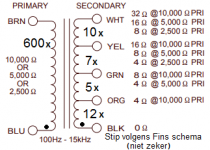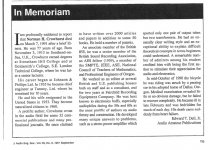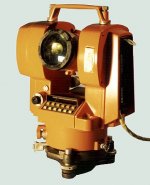I don't know if this is common knowledge, but the current thread on the Hammond 125DSE inspired me to post this little hint. For the Hammond 125xSE transformers, connecting an 8 Ohm speaker to the 32 Ohm and 4 Ohm secondary leads (ignoring the Common lead) gives a 6k primary impedance (5982 Ohms).
Here a drawing with the number of windings between the connections.
Is this case from 4Ω to 32Ω we have 5+7+10=22x giving a transformation ratio of 600/22=27,3.
If you connect 8Ω then the ptimary sees 8 x 27,3 x 27,3 = 5950Ω
Not shure if the same wire is used to get from 16Ω to 32Ω, there is much less current needed for a 32Ω load.
Mona
Is this case from 4Ω to 32Ω we have 5+7+10=22x giving a transformation ratio of 600/22=27,3.
If you connect 8Ω then the ptimary sees 8 x 27,3 x 27,3 = 5950Ω
Not shure if the same wire is used to get from 16Ω to 32Ω, there is much less current needed for a 32Ω load.
Mona
Attachments
The secondary is probably all the same gauge wire. Each time the winder stops,Here a drawing with the number of windings between the connections.
Is this case from 4Ω to 32Ω we have 5+7+10=22x giving a transformation ratio of 600/22=27,3.
If you connect 8Ω then the ptimary sees 8 x 27,3 x 27,3 = 5950Ω
Not shure if the same wire is used to get from 16Ω to 32Ω, there is much less current needed for a 32Ω load.
Mona
even to bring out a tap costs money. From the horse's mouth, a colleague inside Hammond.
For me Hammond was both a supplier of transformers & a customer of the test
equipment I was selling. Got to know many people inside.
Can you find a loudspeaker with a constant impedance across the audio frequency band?
What manufacturer and model number?
Please post it here.
Speaker impedance ratings are Nominal, are not constant with frequency.
Even if the impedance is constant, is it resistive, capacitive, inductive, or a combination of those?
Starting with a specified tube plate resistance, transformer primary impedance, transformer turns ratio that gives the rated secondary impedance . . . to drive a loudspeaker is only an approximation.
By the way, the tube plate resistance, rp, varies as the tube current varies.
In a single ended amplifier, the amplifier output impedance varies as the signal goes through its range.
It is not constant from the positive alternation versus the negative alternation (asymmetrical).
Generally, Class A1 single ended amplifiers do not respond very well with loudspeaker loads that are reactive (elliptical load lines).
Negative feedback can reduce this effect, but with other tradeoffs.
A push pull amplifier that is operated in Class A1, has a fairly constant output impedance as the signal goes through its range.
Generally, Class A1 push pull amplifiers do respond very well with loudspeaker loads that are reactive (elliptical load lines).
Just my opinions
All generalizations have exceptions
What manufacturer and model number?
Please post it here.
Speaker impedance ratings are Nominal, are not constant with frequency.
Even if the impedance is constant, is it resistive, capacitive, inductive, or a combination of those?
Starting with a specified tube plate resistance, transformer primary impedance, transformer turns ratio that gives the rated secondary impedance . . . to drive a loudspeaker is only an approximation.
By the way, the tube plate resistance, rp, varies as the tube current varies.
In a single ended amplifier, the amplifier output impedance varies as the signal goes through its range.
It is not constant from the positive alternation versus the negative alternation (asymmetrical).
Generally, Class A1 single ended amplifiers do not respond very well with loudspeaker loads that are reactive (elliptical load lines).
Negative feedback can reduce this effect, but with other tradeoffs.
A push pull amplifier that is operated in Class A1, has a fairly constant output impedance as the signal goes through its range.
Generally, Class A1 push pull amplifiers do respond very well with loudspeaker loads that are reactive (elliptical load lines).
Just my opinions
All generalizations have exceptions
Another option is to connect your 8 ohms load between black and yellow and use the white 16 ohms tap for CFB. By doing this, the secondary winding effectively gets connected in series with the primary and thus increases primary inductance and turns ratio. The CFB lowers distortion and output impedance, at the cost of gain of course.
Got an example of an amplifier you have built & tested based on the principles you have listed?Can you find a loudspeaker with a constant impedance across the audio frequency band?
What manufacturer and model number?
Please post it here.
Speaker impedance ratings are Nominal, are not constant with frequency.
Even if the impedance is constant, is it resistive, capacitive, inductive, or a combination of those?
Starting with a specified tube plate resistance, transformer primary impedance, transformer turns ratio that gives the rated secondary impedance . . . to drive a loudspeaker is only an approximation.
By the way, the tube plate resistance, rp, varies as the tube current varies.
In a single ended amplifier, the amplifier output impedance varies as the signal goes through its range.
It is not constant from the positive alternation versus the negative alternation (asymmetrical).
Generally, Class A1 single ended amplifiers do not respond very well with loudspeaker loads that are reactive (elliptical load lines).
Negative feedback can reduce this effect, but with other tradeoffs.
A push pull amplifier that is operated in Class A1, has a fairly constant output impedance as the signal goes through its range.
Generally, Class A1 push pull amplifiers do respond very well with loudspeaker loads that are reactive (elliptical load lines).
Just my opinions
All generalizations have exceptions
With schematic, photos & test results? Some folks would like you to share with us your experience. 🙂
I designed and built a pair of monoblock amplifiers. I gave a presentation of those amplifier designs, and then gave a listening session using those amplifiers. I did that at a seminar that I presented at VSAC 2008 (design theory, and practical listening).
One amplifier had parallel single ended 300B tubes into a 1600 Ohm SE output transformer (effectively 3200 Ohm load to each 300B).
The other amplifier had push pull 300B tubes into a 6000 Ohm push pull output transformer (effectively a 3000 Ohm load to each 300B, the medium signal level was kept to Class A, as I had designed it).
The damping factor of both amplifiers was approximately the same (I intended that when I designed them).
The loudspeaker impedance did vary with frequency, and the loudspeaker phase did vary with frequency.
I tested the loudspeakers impedance and phase with a $50,000 Rhode & Schwarz Vector Network analyzer and $10,000 precision cal kit, from 10Hz to beyond 20kHz.
A perfect experiment, no.
But it was well attended, and well liked. It was food for thought.
I wish I had the time and energy, I would do that over again, with some changes that would make the experiment even better.
One amplifier had parallel single ended 300B tubes into a 1600 Ohm SE output transformer (effectively 3200 Ohm load to each 300B).
The other amplifier had push pull 300B tubes into a 6000 Ohm push pull output transformer (effectively a 3000 Ohm load to each 300B, the medium signal level was kept to Class A, as I had designed it).
The damping factor of both amplifiers was approximately the same (I intended that when I designed them).
The loudspeaker impedance did vary with frequency, and the loudspeaker phase did vary with frequency.
I tested the loudspeakers impedance and phase with a $50,000 Rhode & Schwarz Vector Network analyzer and $10,000 precision cal kit, from 10Hz to beyond 20kHz.
A perfect experiment, no.
But it was well attended, and well liked. It was food for thought.
I wish I had the time and energy, I would do that over again, with some changes that would make the experiment even better.
Still looking forward to your photos, schematics & test results.I designed and built a pair of monoblock amplifiers. I gave a presentation of those amplifier designs, and then gave a listening session using those amplifiers. I did that at a seminar that I presented at VSAC 2008 (design theory, and practical listening).
One amplifier had parallel single ended 300B tubes into a 1600 Ohm SE output transformer (effectively 3200 Ohm load to each 300B).
The other amplifier had push pull 300B tubes into a 6000 Ohm push pull output transformer (effectively a 3000 Ohm load to each 300B, the medium signal level was kept to Class A, as I had designed it).
The damping factor of both amplifiers was approximately the same (I intended that when I designed them).
The loudspeaker impedance did vary with frequency, and the loudspeaker phase did vary with frequency.
I tested the loudspeakers impedance and phase with a $50,000 Rhode & Schwarz Vector Network analyzer and $10,000 precision cal kit, from 10Hz to beyond 20kHz.
A perfect experiment, no.
But it was well attended, and well liked. It was food for thought.
I wish I had the time and energy, I would do that over again, with some changes that would make the experiment even better.
I've got the sense you were/are a member of the Oregon Triode Society.
I'd think they would expect to have some kind of record you could pull up.
Seems you built very little, not much evidence here or anywhere else I've looked.
Was Norman Crowhurst a member of the Oregon Triode Society?
My clients/customers would not be satisfied with such a minimal response as your post.
So I'm asking the tough questions they routinely asked of me & the company I represented,
in support of their products.That often meant in depth demoes, especially when
they pulled something out I'd never seen before.
Or in the case of the HP Civil Engineering Division, flying to a remote location with four large
orange shipping boxes full of survey equipment. But I got to go to works in Jeans, a hard hat
& safety boots. But the entire resources of the company were always available
to support those of us in the field. 🙂
Attachments
jhstewart9,
I know some of your work experiences, and your audio hobby experiences too. They are impressive.
And I have learned a lot from your postings, and your corrections of my errors too.
You are rightly challenging me, for more illustrations and documents as to the professional and hobby experiences that I have as well. But I do not plan on repeating or improving the experiment I did at VSAC2008.
only those who paid $160 were permitted to attend the seminars, musical performances, and meals at VSAC2008.
All the others paid much less, and so were only permitted to see the hobby rooms, and vendor rooms of the conference.
Unfortunately, most seminars were not recorded in any way.
Thanks for making me think, it got me to create a test that is far simpler than setting up a seminar and listening session similar to the one I did at VSAC2008.
I did come up with a more direct path to show one of the things that I want to illustrate.
If I do that experiment, I will publish it here.
Yes, I am an OTS member.
I am quite certain, Norman Crowhurst was not alive when the OTS was started. He would have been a great addition to the club.
VSAC was started by Dan Schmalle (Bottlehead). He sponsored 3 different conferences at Silverdale, WA.
But he decided not to sponsor another VSAC.
Another person sponsored VSAC2008 at Vancouver, WA. It was the last VSAC ever. Too bad, VSACs were great.
I know some of your work experiences, and your audio hobby experiences too. They are impressive.
And I have learned a lot from your postings, and your corrections of my errors too.
You are rightly challenging me, for more illustrations and documents as to the professional and hobby experiences that I have as well. But I do not plan on repeating or improving the experiment I did at VSAC2008.
only those who paid $160 were permitted to attend the seminars, musical performances, and meals at VSAC2008.
All the others paid much less, and so were only permitted to see the hobby rooms, and vendor rooms of the conference.
Unfortunately, most seminars were not recorded in any way.
Thanks for making me think, it got me to create a test that is far simpler than setting up a seminar and listening session similar to the one I did at VSAC2008.
I did come up with a more direct path to show one of the things that I want to illustrate.
If I do that experiment, I will publish it here.
Yes, I am an OTS member.
I am quite certain, Norman Crowhurst was not alive when the OTS was started. He would have been a great addition to the club.
VSAC was started by Dan Schmalle (Bottlehead). He sponsored 3 different conferences at Silverdale, WA.
But he decided not to sponsor another VSAC.
Another person sponsored VSAC2008 at Vancouver, WA. It was the last VSAC ever. Too bad, VSACs were great.
Last edited:
Here's an early demo I attended. The idea was to compare push-pull and parallel single-ended sound. The results were interesting, but would need much more time to draw any hard conclusions. Interesting nonetheless! PP sounded better on mono sources, and PSE beat it out on stereo sources- even when only one channel was playing... strange!
https://www.enjoythemusic.com/vsac_2008/
I gather that several of us on this thread are in their 70's (or even older - yikes!), so grew up reading Norman Crowhurst. A great teacher and an innovative, seat-of-the-pants, thinker. Something to which we probably all would aspire.
Large public listening demonstrations? / tests? have been attempted at least since the 1932 Bell Labs Stokowski orchestral reproductions. Later replicated by Acoustic Research in the 1950's in live vs. recorded form. (The Bell tests were live vs. long telephone wire.) In both cases, (large) audiences largely reported being unable to distinguish the differences. Does this make these audiences less sophisticated or less nuanced than us?
I'd say that the answer lies in the difficulty of taking a test. We're not the same in a crowd, listening to music analytically, as we are listening to the same music in own safe den, just as that is different from listening to music at a live concert. Especially if that concert is the Grateful Dead or Joni Mitchell or (insert your favorite concert). The public experience can be either positive or negative, but it's a huge effect and uncontrollable. So we get and should expect very noisy data.
All good fortune,
Chris
Large public listening demonstrations? / tests? have been attempted at least since the 1932 Bell Labs Stokowski orchestral reproductions. Later replicated by Acoustic Research in the 1950's in live vs. recorded form. (The Bell tests were live vs. long telephone wire.) In both cases, (large) audiences largely reported being unable to distinguish the differences. Does this make these audiences less sophisticated or less nuanced than us?
I'd say that the answer lies in the difficulty of taking a test. We're not the same in a crowd, listening to music analytically, as we are listening to the same music in own safe den, just as that is different from listening to music at a live concert. Especially if that concert is the Grateful Dead or Joni Mitchell or (insert your favorite concert). The public experience can be either positive or negative, but it's a huge effect and uncontrollable. So we get and should expect very noisy data.
All good fortune,
Chris
- Home
- Amplifiers
- Tubes / Valves
- Hooking up Hammond 125xSE transformers for 6k primary load


